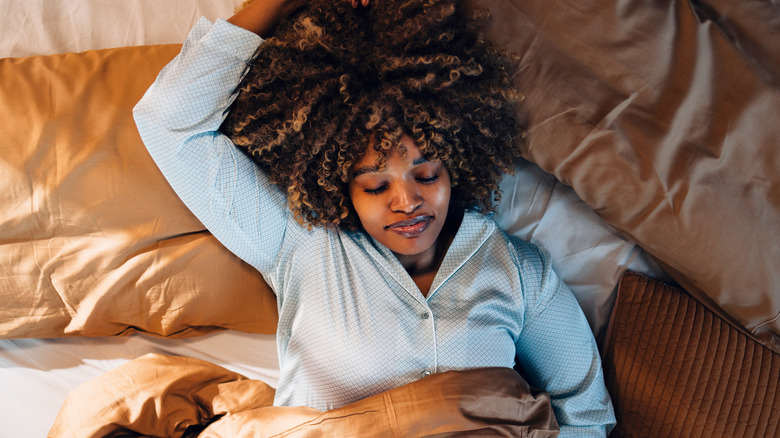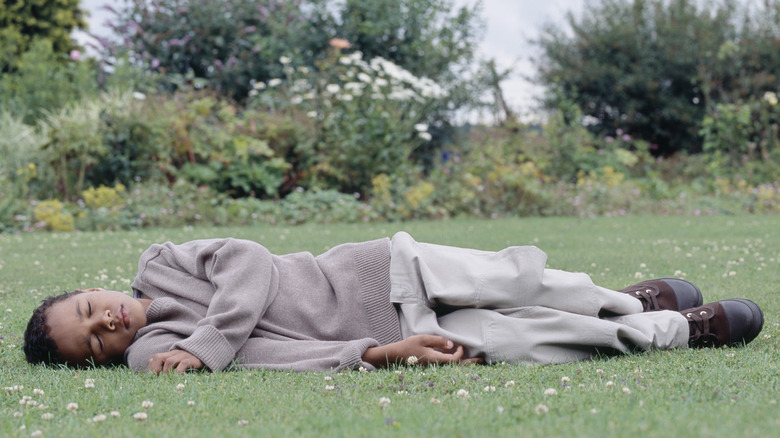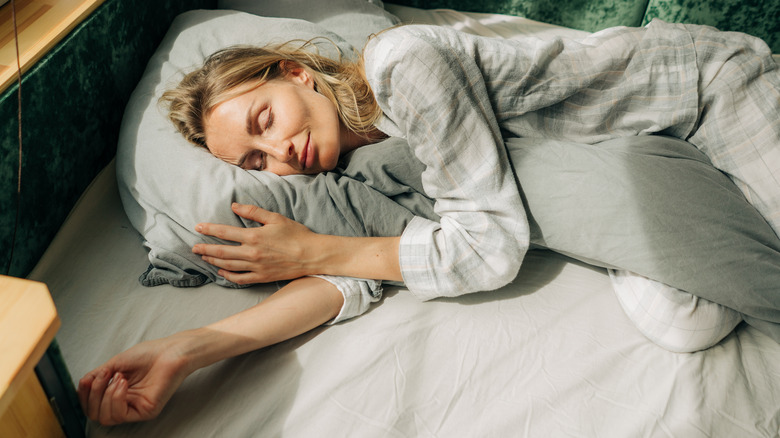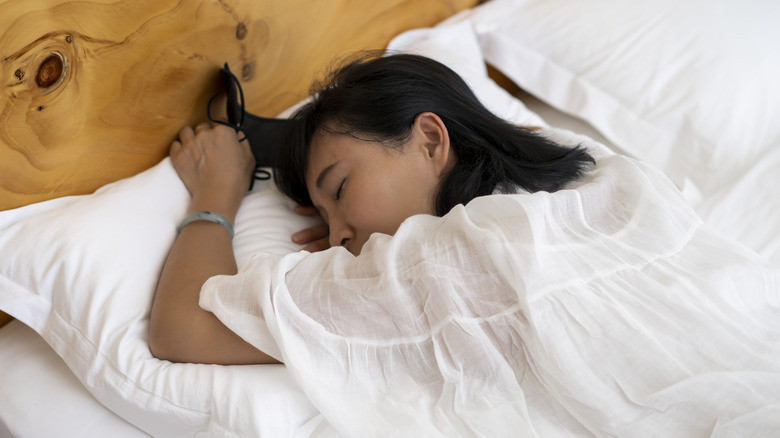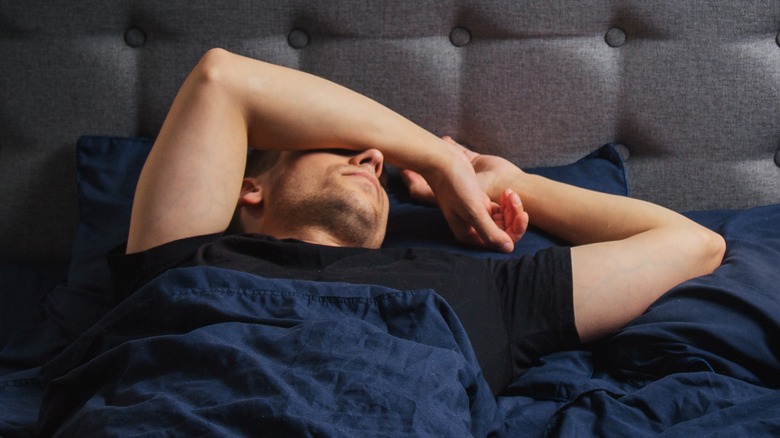What Your Sleep Position Might Say About Your Personality
Move over, horoscopes — there's apparently another way to predict our personalities: the way we sleep. Think this sounds farfetched? You're not alone. A sleep scientist named Samuel Dunkell turned heads in the 1970s by suggesting that sleep positions could signal specific personality traits. Since then, the science community has cast Dunkell's theory some side-eye, as researchers have failed to consistently replicate his results.
However, not everyone has given up on the sleep-personality connection. Today, one of the leading proponents of this theory is Dr. Chris Idzikowski, who leads both the Edinburgh Sleep Centre in Scotland and the Sleep Assessment and Advisory Service in Northern Ireland. In 2003, Dr. Idzikowski surveyed 1,000 British citizens on which of six common sleep positions they preferred. He also asked how they would describe themselves and then looked for commonalities between the two variables. "This is the first time we have been able to see what our subconscious posture says about us," Dr. Idzikowski told BBC News that year. "What's interesting is that the profile behind the posture is often very different from what we would expect."
While Dr. Idzikowski's survey has notable shortcomings — the small sample size, the bias of participants describing their own personalities, and the continued inability to reproduce his findings, to name a few — it's still fun and interesting to see how the survey panned out and what sleep might reveal about our own inner selves. Here's how Dr. Idzikowski characterized each sleeping type, plus additional ways each sleep position may reflect our health and daily life.
Fetal sleepers are often sensitive souls
Back in 2003, Dr. Chris Idzikowski shared the detailed results of his survey with BBC News and, thus, the world. Among other things, his study revealed that the fetal position — curled up on one side like a baby — was the most-common sleeping position, favored by 41% of the 1,000 survey respondents. Based on their answers, Dr. Idzikowski also claimed that while fetal sleepers may appear hardened or bashful on the outside, they have a warm, marshmallow-y center.
But does any of this bear out? While the personality claims haven't been well substantiated, the popularity of the fetal position has been verified by other sources. One extensive 2019 research review in BMJ Open determined that more than 60% of European adults adopt the fetal position for most of their sleeping hours. Meanwhile, a 2017 study in Nature and Science of Sleep suggests that the adult preference for side sleeping increases with higher age or body mass index (BMI). Finally, a 2017 survey conducted by The Better Sleep Council reports that while fetal sleeping has widespread popularity, it's especially preferred by women and Gen X.
While we're on the subject, does the fetal position have any connotations for health and well-being? As it turns out, side sleeping can help with everything from snoring and digestion to lower back pain. It's also a good position for pregnant folks, as side sleeping during pregnancy is tied to better outcomes for both parent and fetus.
Log sleepers tend to be social butterflies
The second-most popular sleeping position from Dr. Chris Idzikowski's survey was, surprisingly, the log position — in other words, lying on one side with arms and legs straight down. It sounds remarkably uncomfortable, but 15% of participants apparently favored this position. In contrast to their stiff sleeping arrangement, Dr. Idzikowski found log sleepers to be lax, sociable, and unguarded to the point of gullibility.
The Better Sleep Council also gleaned some strange factoids surrounding log sleepers. For one, its research found that log sleepers consider themselves particularly healthy compared to other sleepers and consistently report getting enough rest. The council also reports that log sleepers are the most likely to test their mattress before making a purchase.
Health-wise, the log position offers the same advantages as the fetal position, as both are forms of side sleeping. Note that side sleeping is especially beneficial if you lie on your left side — a quirk that can help reduce acid reflux at night, improve blood flow, and reduce organ pressure for pregnant individuals. However, anyone with heart failure may still feel more comfortable sleeping on the right side.
Yearning sleepers can be jaded and stubborn
Among Dr. Chris Idzikowski's participants, 13% opted for the third-most common sleeping style: the yearning position. This means sleeping on one side with outstretched arms. Dr. Idzikowski claimed that this position indicates someone is pessismistic or wary of others. He also suggested that yearning sleepers are indecisive but then become immovable in their decisions once they come to a conclusion. Meanwhile, survey responses from The Better Sleep Council indicate that the yearning position is, for some reason, more common among boomers than millennials and Gen X.
Like the fetal and log positions, the yearning sleep style is technically a form of side sleeping. So if this is your usual sleeping arrangement, you may experience fewer nighttime interruptions from heartburn and snoring. However, there is some evidence that side sleeping can contribute to shoulder pain, including a 2012 study in The Journal of Manipulative and Physiological Therapeutics that found a link between shoulder pain and the side that subjects usually slept on.
Soldier sleepers lean toward becoming private high-achievers
Accounting for 8% of Dr. Chris Idzikowski's survey respondents, the soldier position involves lying flat on your back with your arms and legs straight down. In line with the restrained, at-attention vibe of this sleeping style, Dr. Idzikowski extrapolated that soldier sleepers have restrained personalities but always want to be the best at what they do.
Whether or not you take Dr. Idzikowski's personality claims at face value, what we do know is that back-sleeping styles have various wellness implications. For one thing, back sleeping may contribute to lower back pain, especially if you're on a soft mattress that allows your spine to curve while lying down, compressing its discs. Happily, a quick trick can provide some relief for dedicated soldier sleepers: Simply tuck a pillow beneath your knees to support your lower back.
Similarly, back sleeping is a big no-no for pregnant folks, particularly those in the third trimester. Research conducted by the pregnancy charity Tommy's reveals that back sleeping during late pregnancy can raise the risk of stillbirth. Ideally, pregnant individuals should switch to a side-sleeping position instead.
Freefall sleepers can be spontaneous but easily offended
As if skydiving straight into bed, the freefall sleep position is face-down with arms curved around the pillow and the head turned to one side. While only 7% of Dr. Chris Idzikowski's participants identified themselves as freefall sleepers, he analyzed their other responses to deem freefall sleepers as assertive and chatty but quick to get defensive.
The Better Sleep Council added more curious nuggets to our understanding of freefall sleepers. Not only are millennials and Gen X more likely to lie this way than boomers, but apparently, introverts have a strong distaste for this position. In a roundabout way, this supports Dr. Idzikowski's claim that freefall sleepers are gregarious individuals, though that's not quite empirical evidence.
Introvert or extrovert, freefall sleeping has scientifically backed ramifications for your physical health. For example, stomach sleeping of all kinds may be uncomfortable or even dangerous for folks in late pregnancy. "Sleeping flat on your stomach has the same negative effects as sleeping on your back," Dr. Sara Twogood told The Bump. This means pressure against major blood vessels like the aorta and inferior vena cava that blocks important fluids and nutrients from reaching the fetus. Stomach sleeping can also cause your spine to arch, contributing to back pain. In the same vein, the freefall position's sideways head can misalign your vertebrae, adding to neck or shoulder pain. Stomach sleeping might even be linked to wrinkles since your face spends the night pressed and pulled against your pillow, making it a sleep mistake that could even make you look older.
Starfish sleepers are typically friendly and helpful
The final and least-popular sleeping style studied in Dr. Chris Idzikowski's survey was the starfish position. No, this doesn't mean sprawling across the bed; rather, the starfish position is when someone lies on their back with their arms up near the pillow. Only 5% of participants cited this as their usual sleeping arrangement, and while that shakes out to just around 50 people, Dr. Idzikowski deduced from this small sample size that starfish sleepers are good listeners, eager to help anyone in need, and prefer when others are the focus, not them. According to The Better Sleep Council's survey, men tend to sleep in the starfish sleeping position more than women. Along with log sleepers, starfish sleepers have a higher chance of sleepwalking.
Because starfish sleeping is another face-up style, it carries the same health implications as soldier sleeping, such as back pain and pregnancy risks. Back sleeping — whether in soldier or starfish style — is also the worst-possible arrangement for people suffering from sleep apnea or snoring. "There's a host of evidence overall suggesting that probably sleeping on the side is better," Dr. Virend Somers told the Mayo Clinic last year. So, if you're a regular back sleeper, it might be worth following the crowd and testing the allure of fetal or log sleeping instead. That way, you can reap more mental health benefits of a solid sleep routine.
Now that we've gone through these sleep positions, check out our guide to sleep languages.
